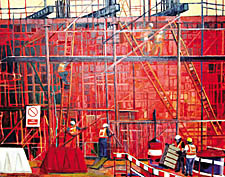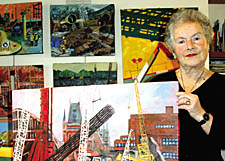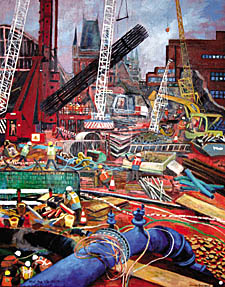|
|
 |
| |
Wanda's building sight
Artist Wanda Garland's latest exhibition is inspired by the redevelopment at King's Cross, writes Dan Carrier
GETTING caught in the traffic around the massive rebuilding
at the King’s Cross development was the inspiration for
a new exhibition by Camden Town artist Wanda Garland.
The former Carlton and Netley Street school teacher, who retired
in 1997 and has been painting full time ever since, would stop
at traffic lights and find herself transfixed by the building
works going on around her.
Originally Mrs Garland’s work had been landscapes in watercolours,
which were exhibited at Hampstead’s Burgh House and a National
Trust centre in Dorset. But now she has turned her easel in
the direction of the King’s Cross building project to capture
the rise of the capitals biggest construction site. And the
resulting 70 works of art, created over a period of four years,
are due to be displayed this spring in the German Gym in the
heart of the area.
“I look at what I have seen and then try to recreate it,”
says Mrs Garland.
“I look for patterns, shapes and colours – which perhaps
comes from my background as a textile designer. This has fed
my fascination with the site. It has been a big adventure.”
Mrs Garland has switched to oils for her King’s Cross project.
With unprecedented access to the site she says the builders
have been only too willing to help her.
She says: “The workman are always interested in what I
am doing, although they are pretty busy. They probably wonder
why on earth I am there.”
She intends to invite them all to the opening night.
The King’s Cross building work has been an inspiration
because the scenery changes on a daily basis.
“The site itself is an extraordinary thing,” she explains.
“I don’t think of the site in terms of a social or
economic context. I see it as a subject that excites me. I can
walk there and get on a train to Europe, but primarily it interests
me as a subject for my work.
“I had never drawn a crane or a digger before. I was fascinated
to track the building project. At first it was all Victorian
arches and then earth and rubble being moved about, twisted
pipes and mangled ironwork.
“Gradually that has disappeared and now it is scaffolding
and concrete and cranes instead of diggers.”
Many of her works to be bought by railway enthusiasts who want
a record of what has happened to the terminal.
Mrs Garland came to London in 1946. Originally from Poland,
she says her experiences of war-torn Europe has also inspired
the show.
“As a refugee from central Europe after the war, the London
I first saw was littered with bomb sites and the exposed skeletons
of destroyed buildings – King’s Cross reminded me
of this.”
Her family were art collectors but when war broke out, their
life in Krakow was turned upside down. Her family fled east
to the Ukraine to escape the invading Nazis.
They stayed in Ukraine before being exiled in Soviet Union.
“I travelled to England where I already had family and
settled in Camden Town 40 years ago,” she recalls.
Her husband Ken Garland is a graphic designer and lecturer.
He championed the designer Harry Beck, who was responsible for
the design of the Tube map, who was little known at the time.
And Mrs Garland’s background is also in design: she studied
art at the Hornsey Art College and then St Martins before becoming
a textile designer, before turning to teaching.
Her out put has been such that since 1997 she has produced enough
work for a solo exhibition each year – but this is the
first which features such industrial scenes.
“It has become an obsession,” she admits.
“I have not set out to make a record of King’s Cross
– I am not here to make value judgements of the work. I
am just interested in what has been going on.”
|
|
 |
|



